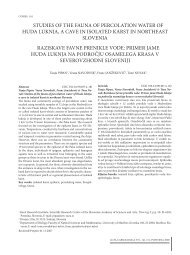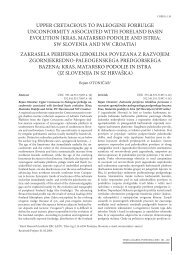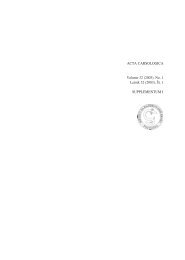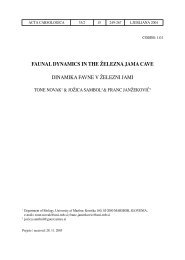Download pdf - Acta Carsologica - ZRC SAZU
Download pdf - Acta Carsologica - ZRC SAZU
Download pdf - Acta Carsologica - ZRC SAZU
Create successful ePaper yourself
Turn your PDF publications into a flip-book with our unique Google optimized e-Paper software.
Stanka ŠEBELA<br />
to 30 Hz). But, thin and long stalactites may be broken<br />
(Lacave et al. 2001).<br />
Regarding ice as a cause for broken speleothems I<br />
think we need representative proofs. Delaby (2001) stated<br />
that it seems very unlikely that the Hotton cave was<br />
affected by frost or permafrost. This is confirmed by the<br />
total absence of cryo-clastic features in the surrounding<br />
limestone host rock. Frost would probably cause the stalagmite<br />
to crumble while the observed breaks are very<br />
clean and occur in the lower half of the stalagmite (Delaby<br />
2001). Ice is a kind of cave filling that leaves almost<br />
no traces (Becker et al. 2006)<br />
The entrance of Snežna Jama (1556 m above sea<br />
level) in Slovenia, is filled with ice and in the cave the effect<br />
of the ice on the speleothems is obvious (Gilli 2004).<br />
Regarding our experiences the presence and the effect<br />
of ice in Postojna Cave described by Kempe (2004) and<br />
Gilli (2004) is more doubtful. The ice was probably not so<br />
widespread in the cave as is described by Kempe (2004).<br />
With this article I want to show good proofs for<br />
broken speleothems related to tectonic deformations.<br />
An overview of selected literature will hopefully provoke<br />
new prospective studies.<br />
BROKEN SPELEOTHEMS IN KARST CAVES<br />
The principle causes recognized for speleothem breakage/disruption<br />
in karst caves are:<br />
1) Instability of the ground due to its composition<br />
(loose sand or clay).<br />
2) Removal of grounding due to water flow<br />
3) Collapse of cave floor (for example into underlying<br />
passage).<br />
4) Gravitational deformation close to valleys<br />
5) Ice<br />
6) Changes in drip water resulting in dissolutional<br />
loosening of ceiling deposits (for example the falling<br />
shield in Škocjanske Jame (Kranjc 1999)).<br />
7) Earthquakes (Bini et al. 1992)<br />
8) Anthropogenic impacts (accidental, mining)<br />
9) Faunal impacts (cave bears, bats etc.)<br />
About broken flowstone in Slovene<br />
caves<br />
In 1830, in Postojna Cave, Hohenwart first recognized<br />
that fallen stalagmites and stalactites required unusual<br />
conditions, and that they might represent geologically<br />
important information. He did not, however, determine<br />
the specific causes for broken speleothems.<br />
In Postojna Cave it was found that stalactites were<br />
broken due to ceiling collapse caused by earthquakes,<br />
and also due to the removal of allochthonous sediments<br />
(Gospodarič 1968). The same author examined the orientation<br />
of broken stalactites and stalagmites in Rov za<br />
Veliko Goro passage of Postojna Cave. The passage is<br />
filled with flysch sediments and covered by flowstone<br />
and collapse blocks. Gospodarič (1968) concluded that<br />
some stalagmites fell down from the ceiling together with<br />
pieces of the limestone bedrock when aggressive percolation<br />
water widened the fissures.<br />
Gospodarič (1968) did not, however, find any<br />
good evidence of earthquake damage from the periods<br />
of flowstone deposition that were from the Atlantic period<br />
(about 6.000-3.000 BC). His directional analysis<br />
of the broken stalagmites from Rov za Veliko Goro did<br />
not reveal any significant particular direction. He also<br />
noted that local ground shaking could be initiated not<br />
only through tectonic processes, but also through ceiling<br />
collapses or through the development of collapse dolines<br />
nearby. However, such local events would not be of sufficient<br />
magnitude to break the flowstone (which was 2<br />
metres thick).<br />
In a subsequent study, Gospodarič (1977) investigated<br />
a broken speleothem dated at 10.000 BC. In this<br />
particular case the speleothem was broken due to consolidation<br />
of the underlying loamy sedimentary floor. It was<br />
later overturned due to earthquake activity. Compression<br />
of loamy sediments is also responsible for consolidation<br />
of the cave floor, and consequently the breakage of flowstones<br />
in Pisani Rov. This process is a long term one, and<br />
therefore cannot be caused by earthquakes.<br />
Gams (2003) mentioned broken stalagmites in<br />
Zgornji Tartarus of Postojna Cave. He also described the<br />
consolidation of clastic sediments as a cause for broken<br />
stalagmites. Perko (1910) believed that a massive stalagmite<br />
called Zvrnjeni steber in Postojna Cave (Figure 1) is<br />
150.000 years old, and fell down more than 67.000 years<br />
BC. He obtained these age results by calculating and extrapolating<br />
from measured deposition rates for flowstone<br />
in the cave. On the Zvrnjeni steber some glass plates (6x3<br />
cm) were installed about 30 years ago. Today some of them<br />
are broken and there is also one that is still cemented but<br />
curved. It looks as if the crack through the stalagmite is<br />
still opening. The movements should be connected with<br />
ground instability and not with tectonics.<br />
52<br />
ACTA CARSOLOGICA 37/1 – 2008







